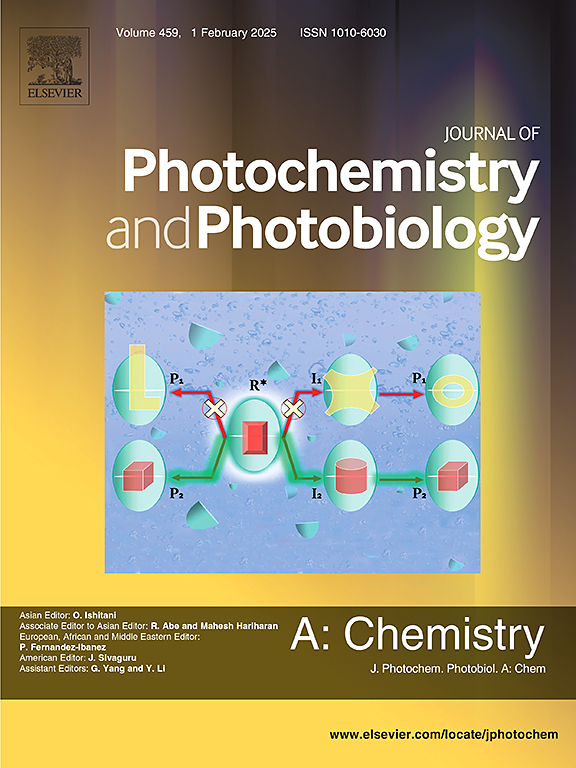热解法和水热法合成石榴皮衍生碳量子点的光动力抗菌潜力
IF 4.1
3区 化学
Q2 CHEMISTRY, PHYSICAL
Journal of Photochemistry and Photobiology A-chemistry
Pub Date : 2025-06-28
DOI:10.1016/j.jphotochem.2025.116603
引用次数: 0
摘要
本研究以石榴皮为原料,在160℃和180℃的温度下,通过热解法(PY-ppCQD)和水热法(HT-ppCQD)合成了碳量子点(cqd)。透射电子显微镜(TEM)显示均匀分散的纳米颗粒直径在2 ~ 5nm之间,晶格条纹表明石墨碳结构。FTIR和XPS分析证实了表面官能团的存在,如羟基、羧基和羰基,这些官能团来自于原料生物质的多酚成分,表明有效地保留了生物活性功能。MTT法对HEK-293细胞的细胞毒性评价显示出剂量依赖性,800 μg/mL浓度对HEK-293细胞有显著抑制作用,支持0 ~ 400 μg/mL浓度作为后续抗菌评价的选择。通过OD600和菌落形成单位(CFU)测量评估cqd对金黄色葡萄球菌(SA)的抑菌效果,显示出浓度依赖性的生长抑制作用,其中PY-ppCQD的活性略优于HT-ppCQD,特别是在400 μg/mL时。在440 nm蓝光照射下,两种CQDs的抗菌活性均显著增强,这是由于活性氧(ROS)的产生诱导细菌膜损伤。扫描电镜(SEM)进一步证实了光照射下py - ppcqd处理组的形态学变形和细胞破裂。这些发现表明,石榴皮衍生的cqs,特别是通过热解制备的cqs,具有很强的内在和光增强抗菌性能,突出了它们作为生物医学和抗菌应用的可持续和多功能纳米材料的潜力。本文章由计算机程序翻译,如有差异,请以英文原文为准。

Photodynamic antibacterial potential of pomegranate peel-derived carbon quantum dots synthesized via pyrolytic and hydrothermal methods
In this study, carbon quantum dots (CQDs) were synthesized from pomegranate peel via pyrolytic (PY-ppCQD) and hydrothermal (HT-ppCQD) methods at 160 °C and 180 °C. Transmission electron microscopy (TEM) revealed uniformly dispersed nanoparticles with diameters ranging from 2 to 5 nm and lattice fringes indicative of graphitic carbon structures. FTIR and XPS analyses confirmed the presence of surface functional groups—such as hydroxyl, carboxyl, and carbonyl moieties—originating from the polyphenolic components of the raw biomass, indicating effective retention of bioactive functionalities. Cytotoxicity assessment using the MTT assay showed dose-dependent effects on HEK-293 cells, with significant inhibition observed at 800 μg/mL, supporting the selection of 0–400 μg/mL for subsequent antibacterial evaluations. The antibacterial efficacy of CQDs against Staphylococcus aureus (SA) was assessed via OD600 and colony-forming unit (CFU) measurements, revealing concentration-dependent growth inhibition, with PY-ppCQD exhibiting slightly superior activity compared to HT-ppCQD, particularly at 400 μg/mL. Under 440 nm blue light irradiation, antibacterial activity was significantly enhanced for both CQDs, attributed to the generation of reactive oxygen species (ROS) that induce bacterial membrane damage. Scanning electron microscopy (SEM) further confirmed morphological deformation and cell rupture, especially in the PY-ppCQD-treated groups under light exposure. These findings demonstrate that pomegranate peel-derived CQDs—particularly those prepared via pyrolysis—possess strong intrinsic and photo-enhanced antibacterial properties, highlighting their potential as sustainable and multifunctional nanomaterials for biomedical and antimicrobial applications.
求助全文
通过发布文献求助,成功后即可免费获取论文全文。
去求助
来源期刊
CiteScore
7.90
自引率
7.00%
发文量
580
审稿时长
48 days
期刊介绍:
JPPA publishes the results of fundamental studies on all aspects of chemical phenomena induced by interactions between light and molecules/matter of all kinds.
All systems capable of being described at the molecular or integrated multimolecular level are appropriate for the journal. This includes all molecular chemical species as well as biomolecular, supramolecular, polymer and other macromolecular systems, as well as solid state photochemistry. In addition, the journal publishes studies of semiconductor and other photoactive organic and inorganic materials, photocatalysis (organic, inorganic, supramolecular and superconductor).
The scope includes condensed and gas phase photochemistry, as well as synchrotron radiation chemistry. A broad range of processes and techniques in photochemistry are covered such as light induced energy, electron and proton transfer; nonlinear photochemical behavior; mechanistic investigation of photochemical reactions and identification of the products of photochemical reactions; quantum yield determinations and measurements of rate constants for primary and secondary photochemical processes; steady-state and time-resolved emission, ultrafast spectroscopic methods, single molecule spectroscopy, time resolved X-ray diffraction, luminescence microscopy, and scattering spectroscopy applied to photochemistry. Papers in emerging and applied areas such as luminescent sensors, electroluminescence, solar energy conversion, atmospheric photochemistry, environmental remediation, and related photocatalytic chemistry are also welcome.

 求助内容:
求助内容: 应助结果提醒方式:
应助结果提醒方式:


